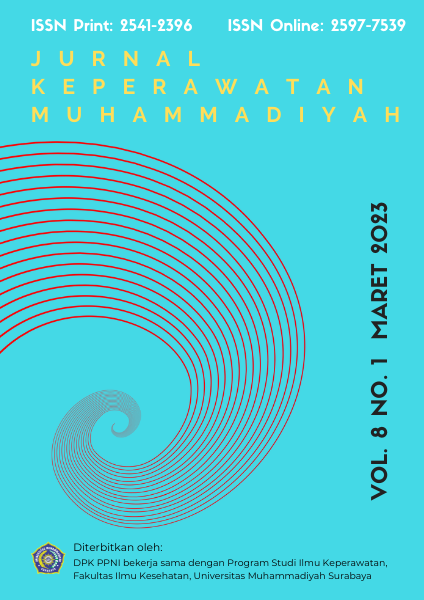Pengaruh Kombinasi Progressive Muscle Relaxation dan Slow Deep Breathing Exercise terhadap Kinesiophobia pada Pasien Rawat Jalan di Surabaya
DOI:
https://doi.org/10.30651/jkm.v8i1.16177Kata Kunci:
progressive muscle relaxation, slow deep breathing exercise, kinesiophobia.Abstrak
Objective: Â Â Kinesiophobia is an excessive fear of physical activity or movement so that patients tend to avoid moving their painful limbs. Not many longitudinal studies have reported that progressive muscle relaxation (PMR) and slow deep breathing exercise (SDBE) have a direct impact on the level of Kinesiophobia. Therefore, we explored the effect of a combination of progressive muscle relaxation and slow deep breathing exercise on kinesiophobia in outpatients with chronic musculoskeletal pain in Surabaya.
Methods: Â Â This study had 43 respondents who all completed a randomized controlled trial (RCT) for 5 weeks, 21 respondents were randomized to receive a combination of progressive muscle relaxation and slow deep breathing exercise and received standard physiotherapy interventions, while the control group consisted of 22 respondents only with standard physiotherapy interventions. The Tampa Scale of Kinesiophobia (TSK) is used to assess the level of Kinesiophobia experienced by patients.Results: Â Â 1. In the experimental group that was given a combination of progressive muscle relaxation and slow deep breathing exercise and standard physiotherapy, the initial mean score without the scale of kinesiophobia (TSK) was 51.73 points, and after the intervention it was 42.32 points.
2. As for the control group which was only given standard physiotherapy intervention, the initial average score without the scale of kinesiophobia (TSK) was 51.71 points, and after the intervention it became 48.33 points.
3. The Effect of a Combination of Progressive Muscle Relaxation and Slow Deep Breathing Exercise on Kinesiophobia in Outpatients in Surabaya, with a p-value = (p <0.05).
Conclusion: Â The combined progressive muscle relaxation (PMR) and slow deep breathing exercise (SDBE) combination technique is safe to apply to patients with Kinesiophobia disorder because it has relatively no side effects and is practical in its application. The findings from this study support that combination therapy of progressive muscle relaxation (PMR) and slow deep breathing exercise (SDBE) offers beneficial outcomes for patients experiencing chronic pain, as well as for preventing and treating Kinesiophobia.
Referensi
Akhtar, M. W., Karimi, H., & Gilani, S. A. (2017). Effectiveness of core stabilization exercises and routine exercise therapy in management of pain in chronic nonspecific low back pain: A randomized controlled clinical trial. Pakistan Journal of Medical Sciences, 33(4), 1002–1006. https://doi.org/10.12669/pjms.334.12664
Bordeleau, M., Vincenot, M., Lefevre, S., Duport, A., Seggio, L., Breton, T., Lelard, T., Serra, E., Roussel, N., Neves, J. F. Das, & Léonard, G. (2022). Treatments for kinesiophobia in people with chronic pain: A scoping review. In Frontiers in Behavioral Neuroscience (Vol. 16). Frontiers Media S.A. https://doi.org/10.3389/fnbeh.2022.933483
Castanho, B., Cordeiro, N., & Pinheira, V. (2021). The Influence of Kinesiophobia on Clinical Practice in Physical Therapy: An Integrative Literature Review. International Journal of Medical Research & Health Sciences, 10(8), 78–94. www.ijmrhs.com
Comachio, J., Magalhães, M. O., Campos Carvalho E Silva, A. P. de M., & Marques, A. P. (2018). A cross-sectional study of associations between kinesiophobia, pain, disability, and quality of life in patients with chronic low back pain. Advances in Rheumatology (London, England), 58(1), 8. https://doi.org/10.1186/s42358-018-0011-2
Eymir, M., Unver, B., & Karatosun, V. (2022). Relaxation exercise therapy improves pain, muscle strength, and kinesiophobia following total knee arthroplasty in the short term: a randomized controlled trial. Knee Surgery, Sports Traumatology, Arthroscopy, 30(8), 2776–2785. https://doi.org/10.1007/s00167-021-06657-x
Kothari, P., Palekar, T., Shah, M., & Mujawar, S. (2019). Effects of conventional physiotherapy treatment on kinesiophobia, pain, and disability in patients with mechanical low back pain. Journal of Dental Research and Review, 6(3), 69. https://doi.org/10.4103/jdrr.jdrr_60_19
Larsson, C., Ekvall Hansson, E., Sundquist, K., & Jakobsson, U. (2016). Kinesiophobia and its relation to pain characteristics and cognitive affective variables in older adults with chronic pain. BMC Geriatrics, 16(1). https://doi.org/10.1186/s12877-016-0302-6
Lockshin, M. D. (2020). Differences between acute and chronic disease: comment on the article by Holman. ACR Open Rheumatology, 2(5), 300. https://doi.org/10.1002/acr2.11146
Luque-Suarez, A., Martinez-Calderon, J., & Falla, D. (2019). Role of kinesiophobia on pain, disability and quality of life in people suffering from chronic musculoskeletal pain: A systematic review. British Journal of Sports Medicine, 53(9), 554–559. https://doi.org/10.1136/bjsports-2017-098673
Musa Eymir, B. U. & V. K. (2022). Relaxation Exercise Therapy Improves Pain, Muscle Strength, and Kinesiophobia. 30(Arthroscopy), 2776–2785. https://pubmed.ncbi.nlm.nih.gov/34230983/
Özer Kaya, D., & Toprak Çelenay, Ş. (2019). Effectiveness of relaxation training in addition to stabilization exercises in chronic neck pain: A randomized clinical trial. Turkish Journal of Physiotherapy and Rehabilitation, 30(3), 145–153. https://doi.org/10.21653/tjpr.665131
Papers, R., & Honkomp, L. (n.d.). If You’re Reading This, Release the Tension in Your Shoulders: A Study of Progressive Muscle Relaxation and Anxiety Relief For Injury Prevention in Athletes. https://opensiuc.lib.siu.edu/gs_rp
Pazzinatto, M. F., Rio, E. K., Crossley, K. M., Coburn, S. L., Johnston, R., Jones, D. M., & Kemp, J. L. (2022). The relationship between kinesiophobia and self-reported outcomes and physical function differs between women and men with femoroacetabular impingement syndrome. Brazilian Journal of Physical Therapy, 26(2). https://doi.org/10.1016/j.bjpt.2022.100396
Vrushali Panhale. (2020). SIPCON 2020 Platform Presentation. Journal of Society of Indian Physiotherapists, 4(1), 16–35. https://doi.org/10.18231/j.jsip.2020.006
Wang, H. C., Su, Y. C., Luk, H. N., Wang, J. H., Hsu, C. Y., & Lin, S. Z. (2020). Increased risk of strokes in patients with chronic low back pain (CLBP): A nationwide population-based cohort study. Clinical Neurology and Neurosurgery, 192. https://doi.org/10.1016/j.clineuro.2020.105725
Wasiuk-Zowada, D., Knapik, A., Szefler-Derela, J., Brzęk, A., & Krzystanek, E. (2021). Kinesiophobia in stroke patients, multiple sclerosis and parkinson’s disesase. Diagnostics, 11(5). https://doi.org/10.3390/diagnostics11050796
Weermeijer, J. D., & Meulders, A. (2018). Clinimetrics: Tampa Scale for Kinesiophobia. Journal of Physiotherapy, 64(2), 126. https://doi.org/10.1016/j.jphys.2018.01.001
WHO. (2022). Musculoskeletal health (p. July 14). WHO. https://www.who.int/news-room/fact-sheets/detail/musculoskeletal-conditions#
Unduhan
Diterbitkan
Terbitan
Bagian
Lisensi
- Penulis tetap memegang hak atas karyanya dan memberikan hak publikasi pertama kepada jurnal ini yang secara simultan karya tersebut dilisensikan di bawah:Â Creative Commons Attribution-ShareAlike 4.0 International (CC BY-SA 4.0)













